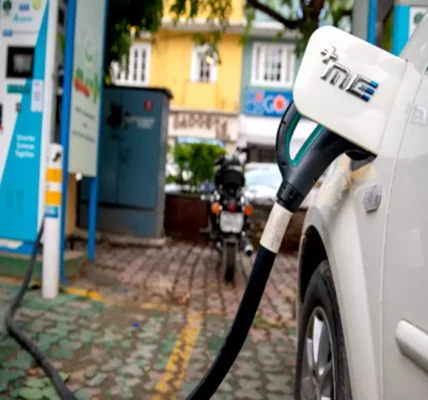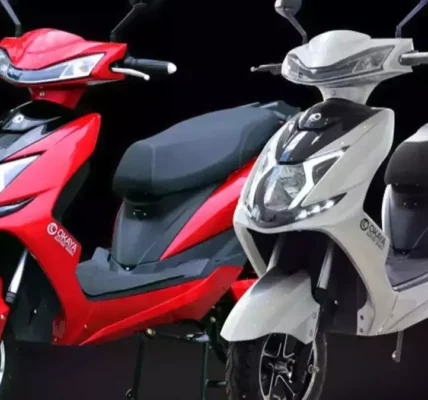Monitoring and data presentation through reports are made possible by IoT in EV charging, in addition to sending real-time alerts to consumers. All value chain stakeholders stand to gain significantly from IoT in terms of automating operations, user authentication, remote management, power consumption statistics, payment and settlement, software upgrades, predictive maintenance, etc.
The Internet of Things (IoT) is a revolutionary technology that allows physical devices, including gadgets, vehicles and buildings, to be interconnected through electronics, sensor technology, wireless technology, actuators and software. This enables devices to collect, interpret, and exchange data in real-time, thereby enabling them to become smart and connected devices. Through this technology, objects can communicate and interact with their surroundings, making them capable of remote monitoring and control through cloud-based control systems.Each device in the IoT is given a unique IP address and is connected to the Internet. This connectivity allows for the exchange of data between devices and enables devices to act through actuators. Sensors within these devices can collect information about their environment and transmit it to other devices or systems.
According to estimates, the Indian market for electric vehicle (EV) charging is projected to expand at a compound annual growth rate (CAGR) of 46.5 percent until 2030. NitiAayog has stated that in order to accommodate the anticipated growth in EV sales, India must set up a minimum of almost 4 million EV charging stations by 2030, a figure significantly greater than that envisaged by current policies. To not only support the expected increase in EV sales, but also encourage further adoption of EVs in the face of escalating climate-related disasters, it is imperative to expedite the development of EV infrastructure in the country.
EV charging stations comprise equipment that is interconnected with third-party service providers. They employ a number of protocols to facilitate smooth operations. Monitoring and data presentation through reports are made possible by IoT in EV charging, in addition to sending real-time alerts to consumers. All value chain stakeholders stand to gain significantly from IoT in terms of automating operations, user authentication, remote management, power consumption statistics, payment and settlement, software upgrades, predictive maintenance etc. Most importantly,IoT enables advance slot booking and scheduling for EV charging; these bookings can be made according to the user’s preferred location, time and charging duration, which is essential to drastically improve customer experience. It can also better accommodate fleet owners and battery swapping.
While installing charging stations at the pace needed as per NitiAayog’s predictions is certainly a challenge, the bigger problem lies in successfully managing a huge number of devices that are dispersed across a vast geographical area. As the number of devices connected to the IoT continues to grow, the network is facing two major issues: security and scalability.
The vulnerability of IoT networks to external cyberattacks and data breaches is one of their key security concerns. Due to lack of adequate security and protection, IoT devices and networks are susceptible to various attacks and hacks, including distributed denial of service attacks. Every IoT-connected object creates privacy and security issues since hackers might steal data and even take remote control of vehicles and gadgets. Corporations may also gain access to confidential information, aside from hackers. Device spoofing and impersonation are further threats.
IoT networks encounter scalability problems too as the number of devices increases. Centralised systems, which authenticate and connect nodes in a network, can become bottlenecks, causing the server to crash and the network to fail. Therefore, servers must be equipped to handle the high volume of data exchange in the network.
Both these problems can be mitigated by using blockchain technology, which can dramatically improve the security of information in IoT networks. It is a decentralised digital ledger that allows for secure and direct exchange of data between participants using encrypted identities without the need for intermediaries. Every transaction or event is validated collectively through a consensus process and then added to an immutable transaction chain distributed across network nodes. A single point of failure might occur in an IoT security architecture using a centralised client-server model controlled by a central authority. By decentralising decision-making to a consensus-based network of devices, blockchain makes the network more resistant to hacker assaults and data breaches.
Blockchain technology can also vastly improve the scalability of IoT networks. The growing number of devices in centralised systems can create bottlenecks. However, blockchain renders intermediaries like central brokers unnecessary, and devices can authenticate each other as legitimate nodes directly registered on the blockchain. This eliminates the need for central brokers and can dramatically boost scalability, enabling the network to handle billions of devices without additional server capacities.
The tamper-proof distributed ledger of blockchain eliminates the requirement for trust between parties and gives no one organisation authority over the enormous volume of data produced by IoT devices. Furthermore, bypassers are prevented from obtaining access to the network, and false overwriting of existing data records is prevented by strong encryption. Blockchain’stransparency makes it possible to pinpoint particular sources of data leaks. Another significant benefit of blockchain is the rapid processing of transactions and coordination across enormous networks of linked devices, improving scalability.
In addition to security and scalability issues, sensitive IoT-enabled systems deal with connectivity concerns as well. They cannot rely on cloud-based connectivity. There is a need for locally-managed IoT devices with the ability to sync with the cloud as and when connectivity is available. This creates a parallel reliable ad resilient system without an appreciable cost. These devices can be a clone of the cloud management system at the micro level, with embedded AI and embedded blockchain nodes, which has not occurred to many players in the market.
Peer-to-peer trading is considerably improved by IoT networks using blockchain technology by optimisingparticipantcommunication, improving transparency, and removing the need for middlemen. Working together, IoT and blockchain eliminate error and increase efficiency by providing information directly from the device to the appropriate party. This creates new business models and opportunities by opening up new options for decentralised and secure P2P transactions.
There is a growing trend towards a decentralised, distributed, and transactive electric grid. This is directly applicable to today’s EV charging business model, which must be brought off-grid in order to make it sustainable. The current business model fails to be profitable for operators due to high capital costs and the fact that rate recovery does not support the returns on investment. Capital investment includes not only installation of EV chargers, but also increase in the distribution transformer size and hence the sanctioned load. Upgrade to the grid infrastructure must be avoided; this is possible through bringing EV charging off-grid to rooftop solar. It is also essential to improve the solar investment by EV charging station ownersby redirecting this solar energy to other site loads during the absence of EV charging.
The second layer is a carbon trading system to lend additional profitability to EV charging station owners. Local IoT devices help in tracking the generation of renewable energy and also keep an auditable record of renewable energy used for the purpose of EV charging ona real-time basis.
This results in real-time calculations of carbon credits, which are recorded and auditable. As it stands today, all the carbon credits calculations are paper calculations, which, as per reports,are exaggerated by a factor of 3.In certain markets, the carbon credits earned through renewable energy-based EV charging are multi-fold (10x in some cases) compared to other kinds of carbon displacement. This will help retail chains and large corporates aggregate carbon credits and seamlessly offer them through a dedicated platform in the market, further augmenting the profitability of the EV charging business in India.
Enabling technologies such as AI and blockchain-enhanced IoT offers flexibility, visibility, and control over renewable energy, allowing tracking, measurement, optimisation, allocation, accounting and trading, starting from the point of generation to the point of consumption, creating millions of auditable renewable energy trails from source to end use. This provides a unique ability to direct the use of renewable energy to specific carbon displacing applications. In doing so, it reveals the precise impact of renewable energy on local decarbonisation and maximises credits; these technologies visualize an EV charging station’s local renewable energy usage, assess optimal renewable energy targets and storage benefits, and quantify the savings arising from shifting to an off-grid IoT-enabled solar energy system.
Renewables-based distributed renewable sources, energy storage and microgrids could lead communities to a net-zero and carbon-free future. But without a solution that benefits all the stakeholders – EV charging operators, EV drivers, local communities and DER developers, among others – in a community-wide manner, none can get close to net-zero. Cutting-edge technologies like IoT can prove to be the key to driving this change.








